16.5 Dam Pros and Cons

Assess the benefits and drawbacks of dams.
According to the U.S. Army Corps of Engineers National Dams Inventory, there are more than 85,000 public and private dams in the United States. Most of these are small embankment dams (or earthen dams) that impound small reservoirs. Figure 16.36 shows the history of dam building in the United States. Canada has about 10,000 dams, and worldwide there are about 850,000 dams.
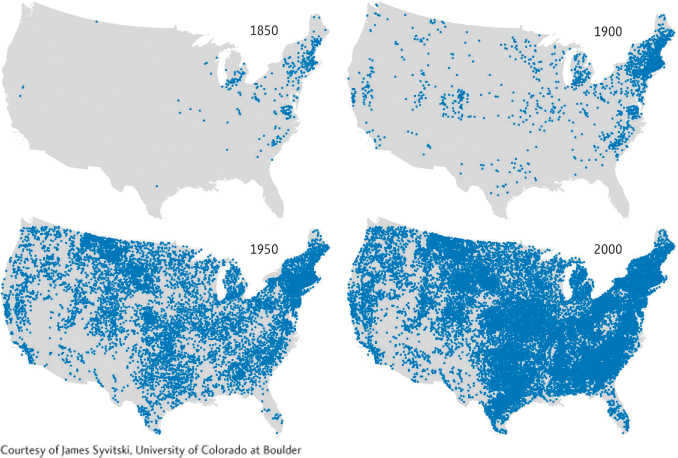
Dams are extremely important structures in most countries and provide many important benefits to society. But there are drawbacks to dams as well. In this section, the pros and cons of large dam projects are weighed.
The Pros of Dams
Water storage: Water is life, and dams provide water. Dams deliver water by storing it in a reservoir and making it available at peak demand periods and in dry seasons. In the United States, dams have played an essential role in the development of arid Western states, and they currently play a crucial role in development in many growing economies around the world. Most of the large cities of the arid western United States, including Phoenix, Las Vegas, Tucson, and Los Angeles, could not have developed to their current sizes without water from reservoirs. The agricultural heartland of California, the Central Valley, would not exist without the extensive series of dams that catch spring snowmelt from the Sierra Nevada and save it for the parched summer months.
Flood control: Dams reduce flood risk by reducing the peak flows of streams during high-
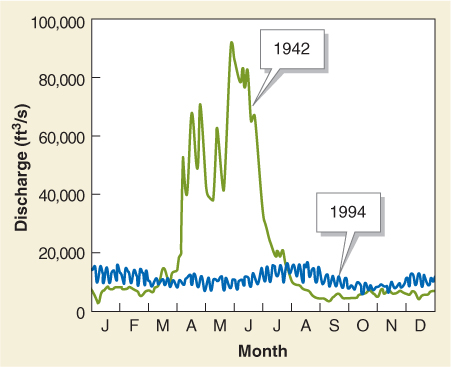
Hydroelectricity: Carbon-
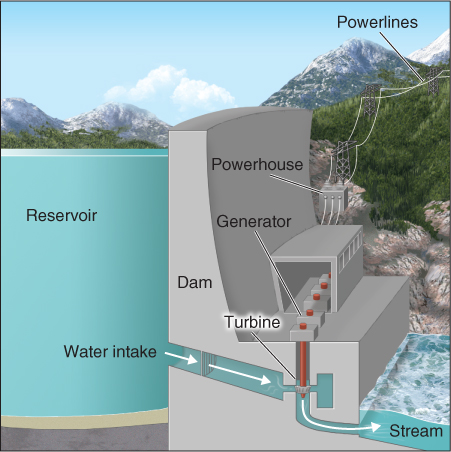
Only about 6% of the energy demand in the United States is met by hydroelectricity. In contrast, over 98% of Norway’s electricity is produced by hydroelectric power plants. Brazil produces 86% of its electricity from streams, and Canada produces over 60% of its electricity from streams. Roughly half of the world’s renewable energy comes from hydroelectricity.
Transportation: Because of dams, many former rivers are now a series of long, narrow lakes that allow large vessels to safely navigate the waterway. The upper Mississippi River, from its headwaters to St. Louis, Missouri, has 43 dams and locks that slow stream flow, providing a transportation corridor essential to the region’s economy.
Recreation: Large reservoirs created by dams provide recreational opportunities for millions of people each year. Activities include water skiing, boating, fishing, swimming, and camping. Recreation on reservoirs is an important part of many local economies.
The Cons of Dams
Reservoirs behind dams provide water for thirsty cities and crops, but they may also destroy stream habitat or preexisting ecosystems and human communities. Other drawbacks of dams include the following:
Reservoir sedimentation: Reservoirs behind dams fill up with sediment because they form a temporary base level. The sediments that accumulate behind dams would have been deposited along coastal regions to help build and maintain coastal beaches. Without these sediments, the beaches erode (see Section 19.3). Furthermore, as reservoirs fill with sediments, their capacity to hold water decreases and sometimes disappears entirely, so that the useful life of the reservoir is limited, as shown in Figure 16.39.
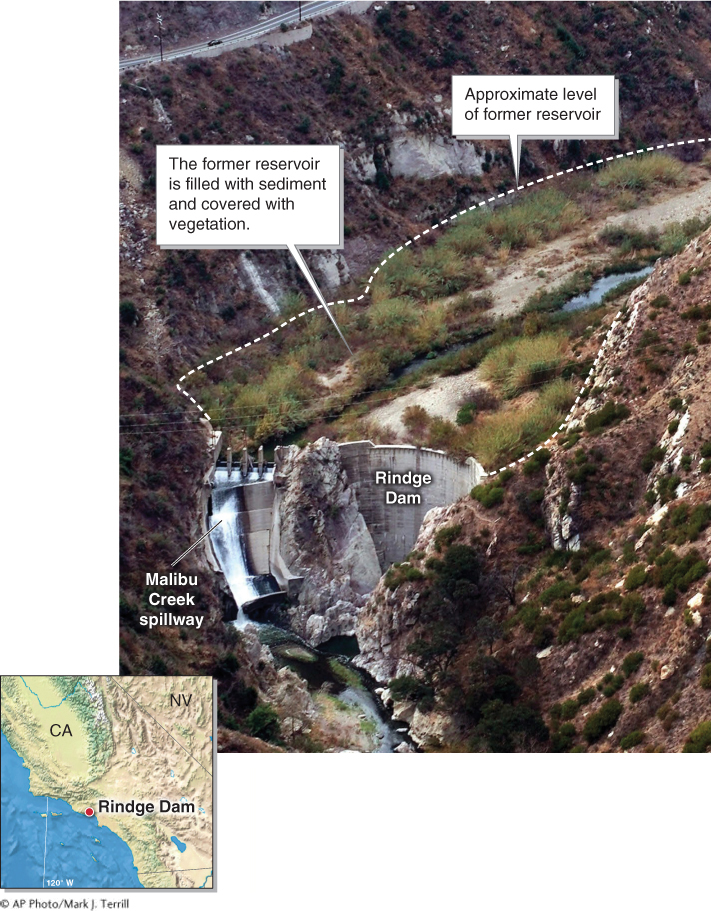
The Aswan High Dam, on the Nile River in Egypt, was completed in 1970 and created artificial Lake Nasser. The Nile River carries a heavy suspended load as it runs through the desert of Sudan and Egypt. The river deposits 120 metric tons of sediment each year in Lake Nasser.
Before the emplacement of the dam, the clays and silts the river carried would settle out on the floodplain along the length of the river and build it up with nutrient-
Loss of cultural sites and habitat: When dams are built, the valleys upstream of the dam are flooded and the stream ecology is destroyed. Lake Powell, the reservoir created by Glen Canyon Dam in Arizona, flooded extensive stretches of the lower Colorado River valley. Slot canyons, natural arches, wildlife habitat, and many active Native American communities and their archaeological sites were flooded, as shown in Figure 16.40.
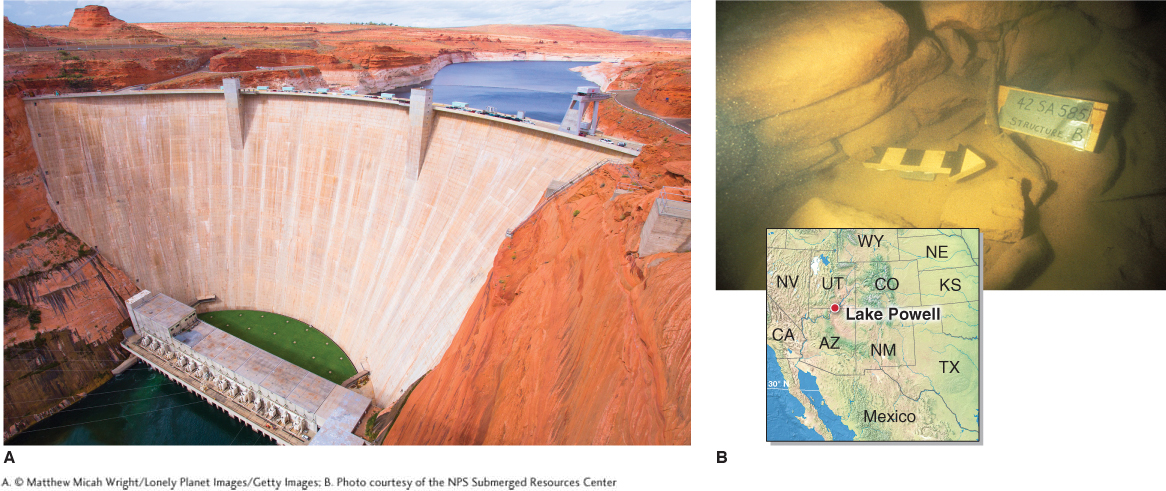
Similarly, the Columbia River watershed has 46 major dams. These dams have been built in rivers in which salmon by the tens of millions once migrated from the Pacific Ocean to spawn in the gravels of small tributary streams. The dams now block the migration of salmon. “Fish ladders” and fish hatcheries were installed on some dam sites. Fish ladders are intended to allow salmon to bypass the structures, but have limited success. Fish hatcheries nurture domesticated (see Section 7.6) salmon, which scientists see as genetically less fit than wild salmon. As a result, and in conjunction with other factors such as commercial fishing, salmon populations throughout the Pacific Northwest are now a fraction of their former numbers.
In response to these problems, some dams are being removed. For example, the Elwha Dam, on the Elwha River in Olympic National Park, Washington State, was removed in 2012, and removal of the Glines Canyon Dam, on the same river, was completed in 2014. The Glines Canyon Dam, built in 1927, was 64 m (210 ft) high, making this the largest dam demolition project in U.S. history (Figure 16.41).
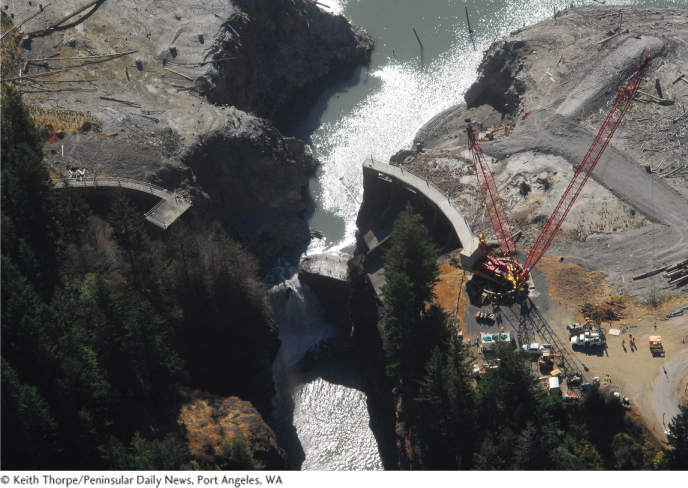
Flooded communities and farmland: Reservoirs created by dams can destroy communities and productive farmland. The Three Gorges Dam, on the Yangtze River in China, is the largest hydroelectric power station in the world. For many, the dam is a technological marvel and an important move away from reliance on energy from coal. To its critics, however, this dam has become symbolic of environmental sacrifice in the name of economic progress. The dam and reservoir forced the relocation of 1.5 million people, many of whom had lived in the area for generations. Some 1,300 archeological sites and 8,000 years of human history were erased when the waters rose.
The Chinese government has nineteen more dam construction projects slated for the upper Yangtze River in the coming decades, most of which will be for hydroelectric power. Similarly, eleven large hydroelectric dams will be built on the lower Mekong River by the governments of Laos, Vietnam, Thailand, and Cambodia in the coming decades. China has built five large hydroelectric projects on the upper Mekong and will have another three completed within the next few years.
Climate change: Reservoirs, particularly reservoirs located in the tropics, produce methane gas through anaerobic decomposition of underwater organic material. Methane is 21 times more potent as a greenhouse gas than carbon dioxide. Large reservoirs in the tropics can emit more greenhouse gases, in the form of methane, than coal-
Taking the Good with the Bad
Although dams have provided many societal benefits, they have come at a cost. In some cases, the cost is relatively slight, while in others it is so steep that maintaining the dam no longer makes sense. Massive new hydroelectric projects in developed countries such as the United States are unlikely because the environmental and societal costs far outweigh the benefits. In developing countries, such as China, Brazil, and India, however, new large dam projects are on the upswing to meet the power and water needs of growing populations.
